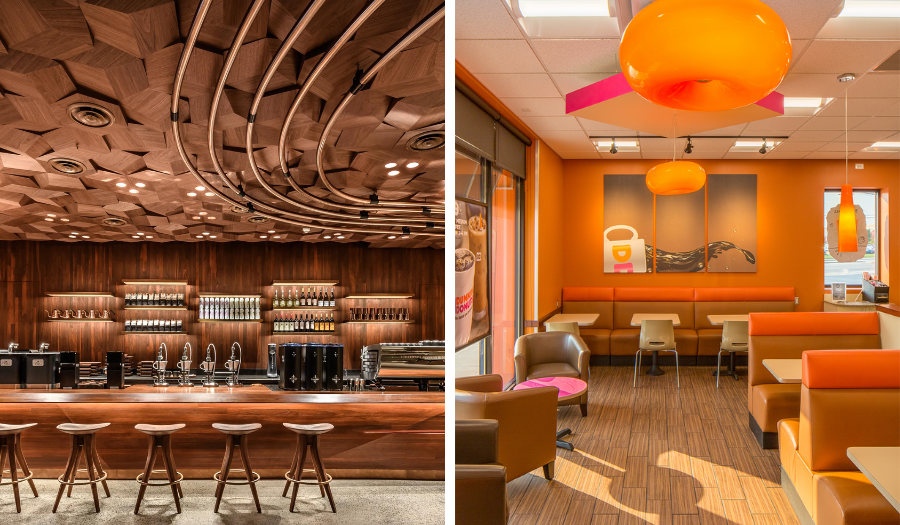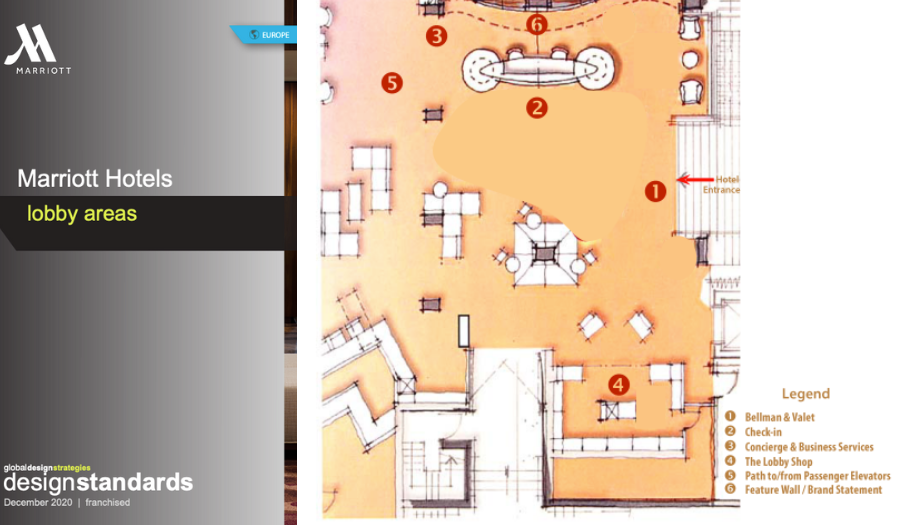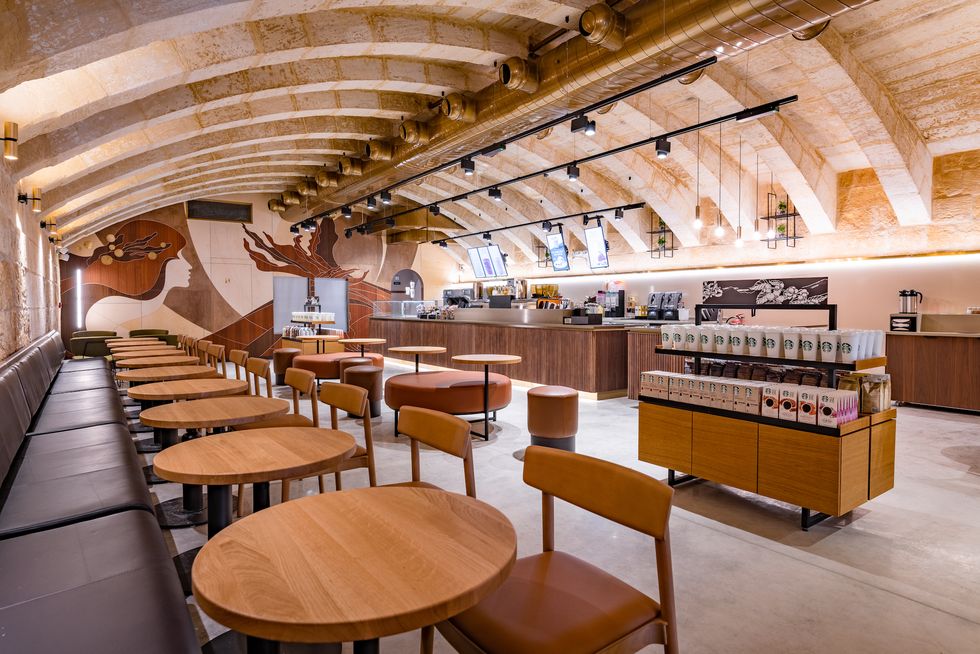Specify, procure, prototype, collaborate, and analyze at scale. Take on bigger projects with confidence and grow your firm with Fohlio. Schedule a demo or book a consultation with one of our account managers to explore these features today.
Think back to the last time you walked into a Starbucks. Now, compare that to your last visit to a Dunkin’. They both serve coffee but trigger completely different emotions. Knowingly or otherwise, your decision to go to one store versus the other was likely influenced by the “vibe” from each place in some way.

Starbucks and Dunkin' interiors provide completely different experiences
“Vibe” is admittedly a terribly vague term, but you probably know what it means (or you can ask a Gen Z-er). It’s that indescribable mix of feelings you get from a person, object, or event – or in this case, a place.
Businesses have a name for it: brand experience. And even though it’s intangible, it’s a very real thing that affects revenue.
Read: Bridging the Design-Implementation Gap: Best Practices for Large-Scale Fit Out Projects
According to McKinsey & Co., companies that deliver a strong brand experience can generate up to 20% higher revenue growth compared to their competitors. It can also mean the difference between building a loyal customer base and watching them drift over to the competition.
Creating that very specific experience for customers is a delicate task – but it gets even trickier when you have to recreate it across several hundred or even thousand locations around the world.
Enter: brand standards.
Brand standards are a crucial tool for creating consistently superior and memorable experiences for guests and customers. It outlines the way each location should look and feel. But beyond being an interior design matrix, brand standards guide the way values are communicated and optimize operations.
We’re going to talk about:
Feel free to jump to a specific topic that’s most interesting to you – just click on a link above.
What are FF&E Brand Standards?
FF&E brand standards are a set of rules and specifications that define how a brand's visual and verbal elements should be used consistently across locations. This includes furniture, bed linen, faucets, floor tiles, and more. All of these components together should reflect brand identity.
Different names for brand standards are brand guidelines, brand identity guidelines, brand style guides, design guidelines, design matrix, brand matrix, and interior design matrix.
The brand standards manual serves as a reference and guide for maintaining consistency and coherence in a brand's interior design and product selection, ensuring that the brand is represented consistently and accurately across different mediums and channels.
Besides functioning as an interior design matrix though, the ideal brand standards also serve as a guideline for which suppliers to use, pricing comparisons, and vendor comparisons.
What are Brand Standards Used For? (Or, Why Brand Standards Should be More Than an FF&E Interior Design Matrix)
Interior design brand standards are important to hotels and retail stores for several reasons:
- Consistency: By having a set of brand standards for interior design, hotels and retail stores can maintain consistency in the look and feel of their spaces across different locations. This consistency helps to reinforce the brand's identity and makes it easier for customers to recognize the brand no matter where they are.
- Customer experience: A well-designed interior can greatly enhance the customer experience. By creating a space that is visually appealing, comfortable, and functional, hotels and retail stores can create a positive impression on their customers and encourage them to spend more time and money in the space.
- Brand identity: Interior design is an important part of a brand's identity. By creating a consistent look and feel across different locations, hotels and retail stores can reinforce their brand's values and personality, and differentiate themselves from competitors.
- Operational efficiency: Having a set of brand standards for interior design can also help hotels and retail stores streamline their operations. By specifying materials, finishes, and layouts, they can ensure that each location is designed to be as efficient and effective as possible, reducing costs and improving the bottom line.
Overall, interior design brand standards are an important tool for hotels and retail stores to create a consistent, memorable, and effective customer experience, while also reinforcing their brand identity and optimizing their operations.
Let’s look at an example of the ways a brand standards manual can benefit a retail or hotel brand.
As an interior design matrix, brand standards provide an FF&E and OS&E materials library of options. Whether it’s used by in-house interior designers or third-party design teams, having pre-approved selections saves a massive amount of time and money.
For example, a Marriott franchisor building a new location won’t have to select linens and nightstands from scratch. The Marriott brand standards will provide him with a list of pre-approved FF&E items that represent brand identity.
This way, guests always know they’re in a Marriott wherever they are in the world.
At the same time, because the brand has already determined all the ways in which they want guests to experience their hotel stay, it’s easier to replicate it across locations. Guests will know what to expect – which means if they like this specific experience, they will more than likely book a Marriott hotel wherever they go.
Finally, having this cohesion means FF&E and OS&E items can be ordered in bigger amounts. This will make it easier for the procurement team to negotiate better deals and terms for the company.
Examples of Brand Standards
Despite its general purpose across the industry, the brand standards manual takes different forms in different companies.
For a smaller firm that usually works with single-family homes, a personal office space, or other one-off projects, this document usually functions as some sort of calling card or portfolio. The main objective is to prove expertise in specific styles like Mid-Century, Minimalist, or Traditional.
Bigger firms, on the other hand, are tasked with creating consistency between locations. It serves as a springboard for new franchises, and can help inform the way the brand represents itself on social media or other mediums.

Another way that brand standards are used differently is due to function. For example, the Americans with Disabilities Act provides regulations for architectural design that accommodates people with disabilities.
The ADA standards for accessible design guidance on building entrances, stairways, signages, and more.

ADA standards for accessible design: guidance for clear width of doorways
Pharmaceutical companies, aerospace companies, semiconductor manufacturers, and hospitals utilize cleanrooms. Cleanroom design standards show how these areas are built specifically to prevent contamination by controlling particulate and microbial dispersion.
There are different kinds of clean rooms and specific standards for each, but in general, the aim is similar. One requirement is for HVAC systems: They must provide air changes 10 times an hour, use high-efficiency filters, and create enough pressure to prevent dirty air from coming in from a different room.
A Brand Standards Guide to Creation
Far from simply being a list of pre-approved FF&E and OS&E items, a brand standards guide outlines a company’s identity and vision, translated into the way it presents itself via interior design. All this is informed by the values the company holds dear.
There are four general components in a brand standards template:
- The design brief is an overview of how design elements are infused throughout the property.
- The interior masterplan is a high-level view of how all the interior spaces come together to form a cohesive whole.
- Specific room guides for FF&E and OS&E provide recommendations for each space, depending on its function.
- The brand standards manual outlines the minimum standards, procedures, and rules required by the brand.
To build a brand standard, you must first define the vision. Who are we? What do we represent? What persona do we want to present to the world? What impression do we want guests to have?
Importantly, how do we communicate these intents and values through design?
Answering these questions will provide you with a design brief.
The interior masterplan lays out strategies for the use of the interior spaces and how they should be integrated. It also discusses vision and branding – you could think of it as straddling the philosophical and concrete.
FF&E and OS&E documents include an FF&E schedule, drawings, and specifications. It is a much more detailed list of products and their descriptions, warranties, installation requirements, and more.
Finally, the brand standards manual details rules and regulations that must be followed during the project. Safety, sustainability, and legal requirements are discussed here. Minimum standards like fire protection and life safety are included, too.
Specify, procure, prototype, collaborate, and analyze at scale. Take on bigger projects with confidence and grow your firm with Fohlio. Schedule a demo or book a consultation with one of our account managers to explore these features today.
